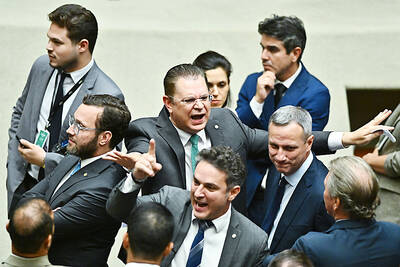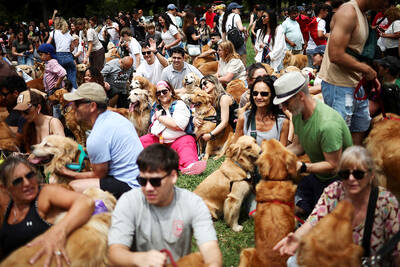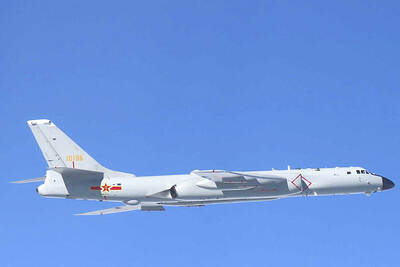North Korean leader Kim Jong-un suffered from a “high fever” during a recent COVID-19 outbreak, his sister Kim Yo-jong said yesterday, as she vowed to “eradicate” South Korean authorities if they continued to tolerate propaganda leaflets the regime blames for spreading the virus.
Kim Yo-jong blamed “South Korean puppets” for sending “dirty objects” across the border in leaflets carried by balloons, the official Korean Central News Agency (KCNA) reported.
The revelation of her brother’s illness marked an unusual admission for a regime that rarely comments on the leader’s health — and then only to show that he shares the struggles of the people.

Photo: Reuters
Kim Yo-jong said in a speech the North Korean leader was “seriously ill” during his bout with fever, KCNA reported.
Still, she added in a quivering voice that her brother “could not lie down for even a moment because of his concerns for the people,” with state TV showing audience members in tears as she delivered her remarks.
She did not say whether the elder Kim was among what North Korea calls “fever cases” or specify the date of his illness. Overweight and a smoker, Kim Jong-un’s health has prompted speculation for years.
Kim Yo-jong delivered a carefully calibrated message to underscore that her brother has suffered, like the country’s citizens, said Rachel Minyoung Lee, regional issues manager at the Vienna-based Open Nuclear Network.
“It is consistent with North Korea’s leadership propaganda strategy in recent years that shifted from deifying the leader to portraying the leader as a regular human being who is constantly with the people and shares his life’s joys and sorrows with the people,” said Lee, who worked as an analyst for the CIA’s Open Source Enterprise for almost two decades.
Kim Jong-un went about 17 days without an appearance in state media last month, but he often drops out of view in summer to spend time at his seaside mansion and megayacht. He attended a ruling party meeting on Wednesday in which he claimed “victory” in the “great quarantine war.”
North Korea has not called its hundreds of thousands of reported fever cases “COVID-19,” perhaps because it lacks a sufficient supply of test kits.
While Kim Jong-un made mention of South Korea in published remarks, his sister issued her first threat against the government of South Korean President Yoon Suk-yeol since it took power in May.
“If the enemy continues to do such a dangerous thing that can introduce virus into our republic, we will respond by eradicating not only the virus, but also the South Korean authorities,” she said in the speech to ruling party members.
The South Korean Unification Ministry expressed “strong regret” over her statement, calling her claims “rude” and unsubstantiated.
The threats were couched in conditional terms, Lee said, adding that “it is uncertain as of now how far North Korea will go to escalate tensions with South Korea.”
Pyongyang’s heated rhetoric against Seoul could set the stage for a resumption of military provocations that have slowed in recent months, possibility due to the outbreak. It appears to be readying to conduct its first nuclear test since 2017, government officials from Japan, South Korea and the US have said.

PARLIAMENT CHAOS: Police forcibly removed Brazilian Deputy Glauber Braga after he called the legislation part of a ‘coup offensive’ and occupied the speaker’s chair Brazil’s lower house of Congress early yesterday approved a bill that could slash former Brazilian president Jair Bolsonaro’s prison sentence for plotting a coup, after efforts by a lawmaker to disrupt the proceedings sparked chaos in parliament. Bolsonaro has been serving a 27-year term since last month after his conviction for a scheme to stop Brazilian President Luiz Inacio Lula da Silva from taking office after the 2022 election. Lawmakers had been discussing a bill that would significantly reduce sentences for several crimes, including attempting a coup d’etat — opening up the prospect that Bolsonaro, 70, could have his sentence cut to

China yesterday held a low-key memorial ceremony for the 1937 Nanjing Massacre, with Chinese President Xi Jinping (習近平) not attending, despite a diplomatic crisis between Beijing and Tokyo over Taiwan. Beijing has raged at Tokyo since Japanese Prime Minister Sanae Takaichi last month said that a hypothetical Chinese attack on Taiwan could trigger a military response from Japan. China and Japan have long sparred over their painful history. China consistently reminds its people of the 1937 Nanjing Massacre, in which it says Japanese troops killed 300,000 people in what was then its capital. A post-World War II Allied tribunal put the death toll

A passerby could hear the cacophony from miles away in the Argentine capital, the unmistakable sound of 2,397 dogs barking — and breaking the unofficial world record for the largest-ever gathering of golden retrievers. Excitement pulsed through Bosques de Palermo, a sprawling park in Buenos Aires, as golden retriever-owners from all over Argentina transformed the park’s grassy expanse into a sea of bright yellow fur. Dog owners of all ages, their clothes covered in dog hair and stained with slobber, plopped down on picnic blankets with their beloved goldens to take in the surreal sight of so many other, exceptionally similar-looking ones.

‘UNWAVERING ALLIANCE’: The US Department of State said that China’s actions during military drills with Russia were not conducive to regional peace and stability The US on Tuesday criticized China over alleged radar deployments against Japanese military aircraft during a training exercise last week, while Tokyo and Seoul yesterday scrambled jets after Chinese and Russian military aircraft conducted joint patrols near the two countries. The incidents came after Japanese Prime Minister Sanae Takaichi triggered a dispute with Beijing last month with her remarks on how Tokyo might react to a hypothetical Chinese attack on Taiwan. “China’s actions are not conducive to regional peace and stability,” a US Department of State spokesperson said late on Tuesday, referring to the radar incident. “The US-Japan alliance is stronger and more